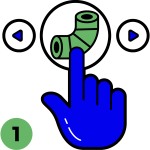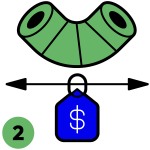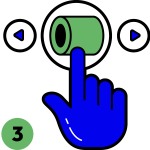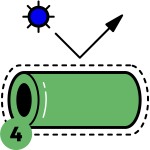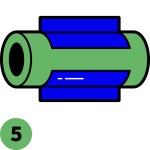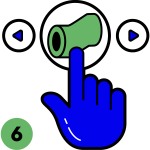
|
|
| ||||||||||||||||||||||||||||||
| "If there be any among us who [disagree], let them stand undisturbed as monuments of the safety with which error of opinion may be tolerated, where reason is left free to combat it." Thomas Jefferson, March 4, 1801 |
Clear PVC Pipe & Acrylic Tube |
Sch 40 White PVC Plumbing Pipe |
Sch 80 Gray PVC Plumbing Pipe |
Furniture Grade Glossy White Pipe |
PVC CTS CPVC Pipe |
Thinwall PVC Pipe |
Metric PVC Pipe |
by Eric, Technical Support for FlexPVC.com a division of PVC Distributors LLC, Pahrump, Nevada
Nominal Ball Valves
First of all, what does "Nominal" mean?
Nominal means "in name only." For example a 1/2" pipe is not 1/2". Just like at the lumber store a "4x2" is not 4" x 2". These are nominal names. A 1/2" Sch 40 pipe is almost 5/8" ID (inside diameter) and almost 7/8th OD (outside diameter, see http://dims.flexpvc.com) So why do they call it 1/2"? It's just tradition. It's about 1/2", but the tolerance is the OD (Outside Diameter) not the ID (Inside Diameter). What that means is the OD is EXACT. In the case of a 1/2" pipe the OD will be exactly .840" +/- .002". But the inside, well it could be .625", .640", .6", .680", etc. You'd have to see how pipe is made to understand it but it's stretch extruded through a die. The die confirms the outer diameter and the stretch creates the ID. Confusing, I know.So just like a 4x2 (lumber) is 3.5" x 1.75" a 1/2" pipe does not mean it's 1/2" on the ID. It's pretty close, but not really 1/2". If you look at the chart at http://dims.flexpvc.com you will see sometimes the "nominal" size is exactly the ID of the pipe, but not always. And of course the OD (the thing most people see and actually measure) has nothing to do with the size of the pipe. But of course it's the only thing that is made to a specific dimension! :-)
So what does this have to do with Nominal Ball Valves? Well they are worse. A 1/2" Nominal Ball valves is about 1/2" ID. But 1/2" pipe is .625-.640" ID. A 2" Nominal Ball valve is about 1.5" ID. If you don't believe me, go look at some. It does not matter who makes them or who you buy them from. They are all about the same. Most people just assume when you buy a certain size ball valve it'll pass the same flow as the same size of pipe. This is a mistake even pros make. If you run thinwall pipe to get the maximum flow possible for a given pipe size, the ball valve could be way less.
Here is a table of nominal ball valves, the Sch 40 pipe ID, the Class 200 pipe ID, the actual Ball Valve ID, and the percentage of loss over the pipe without the ball valve.
| Nominal Size | Pipe ID (Sch 40)" | Cross Sectional Area | Pipe ID (Class 200)" | Cross Sectional Area | Ball Valve ID" | Cross Sectional Area | Ball Valve % Loss over Sch 40 pipe | Ball Valve % Loss over Class 200 pipe |
|---|---|---|---|---|---|---|---|---|
| 1/2" | .622" | .303sq" | .716" | .403sq" | .525" | .216sq" | 29% | 46% |
| 3/4" | .824" | .533sq" | .930" | .679sq" | .725" | .413sq" | 23% | 39% |
| 1" | 1.050" | .866sq" | 1.189" | 1.11sq" | .960" | .724sq" | 16% | 35% |
| 1-1/4" | 1.380 | 1.500sq" | 1.502" | 1.77sq" | 1.15" | 1.040sq" | 41% | 46% |
| 1-1/2" | 1.610" | 2.036sq" | 1.72" | 2.32sq" | 1.325" | 1.38sq" | 32% | 41% |
| 2" | 2.067" | 3.25sq" | 2.149" | 3.63sq" | 1.750" | 2.41sq" | 26% | 34% |
| 2-1/2" | 2.469" | 4.79sq" | 2.601" | 5.31sq" | 2.350" | 4.34sq" | 10% | 18% |
| 3" | 3.068" | 7.39sq" | 3.166" | 7.87sq" | 2.55" | 5.11sq" | 31% | 35% |
| 4" | 4.026" | 12.73sq" | 4.072" | 13.02sq" | 3.35" | 8.81sq" | 31% | 32% |
I know those number seem like very small differences, and they are on their face, but when you look at the reduction in the percentage of cross sectional area (and therefore flow) they can be huge losses!
So what is the solution? It's pretty easy. Just buy one size larger ball valve and then use reducer bushings to take it back down to the pipe size you are actually using.
Ball Valves Found Here (As well as gate valves & blade valves which generally don't have this problem.)
Slip/Spigot Reducer Bushings Found Here (For slip socket ball valves.)
MPT/FPT Reducer Bushings Found Here (For female pipe threaded ball valves.)
We also did a video showing this information on our youtube channel.
|
Just remember: |

|
Unless YOU do something about it!: |
Eric
FlexPVC.com
All Rights Reserved PVC Distributors LLC
|
Home Contact SIGN UP FOR OUR EMAIL LIST - for free gifts every month, discount codes and product announcements. |
FAQ Application Guidelines Technical Articles Technical References Technical Videos Prop 65 Warning |
Privacy Statement Terms & Conditions Warranty Disclaimer Shortcuts Shopping Cart Sitemap |
Our Charities & other important issues. Plumbing & Irrigation Directory Location:216.73.216.125 Links Blog KeyCDN and Bunny.NET work well. |
| All text, images, layout and design Copyright 2002 - 2025 FlexPVC ®, PVC Distributors LLC. - - - FlexPVC ® is a Registered Trademark of PVC Distributors LLC | |||



